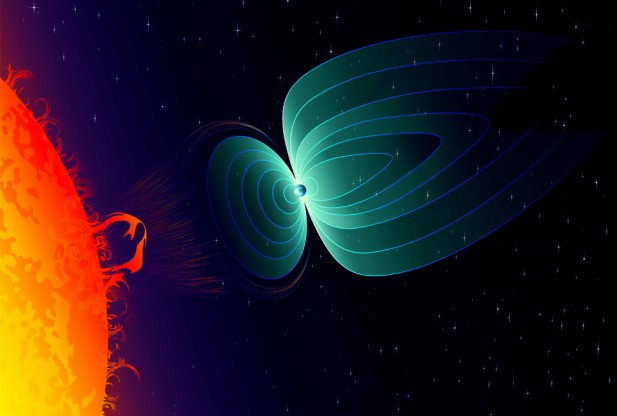
© daulon/ShutterstockEarth's Magnetic Field and Solar Wind.
Scientists writing in the journal
Proceedings of the National Academy of Sciences (PNAS) said the magnetic gravity fields of Earth are going through some changes.
Earth's magnetic field is generated by flows of liquid iron in the outer core. The Earth's magnetic field protects us from cosmic radiation particles.
By understanding these processes in the outer core, scientists are able to have a better grasp of the terrestrial shield. A key to this is measuring the geomagnetic field itself, and also by measuring minute changes in gravity caused by the flow of the liquid Earth's core.
The team has succeeded in providing the first evidence of such a connection of fluctuations in the Earth's gravity, and magnetic field.
They used field measurements of the GFZ-satellite CHAMP and extremely accurate measurements of the Earth's gravity field derived from the GRACE mission.
"The main problem was the separation of the individual components of the gravity data from the total signal," said Vincent Lesur from the
GFZ German Research Centre for Geosciences.
A satellite measures the total gravity, which consists of the mass fractions of Earth's body, water and ice on the ground and in the air.
In order to determine the mass redistribution by flows in the outer core, the attained share of the total gravity needs to be filtered out.
"Similarly, in order to capture the smaller changes in the outer core, the proportion of the magnetic crust and the proportion of the ionosphere and magnetosphere need to be filtered out from the total magnetic field signal measured by the satellite," Lesur said.
The team focused on an area between the Atlantic and the Indian Ocean during the investigation.
They saw extremely fast changes, or magnetic jerks, in 2007 at the Earth's surface. These are an indication for sudden changes of liquid flows in the upper outer core, and are important for understanding the
magneto-hydrodynamics in the Earth's core.
The scientists used the satellite data to see a clear signal of gravity data from the Earth's core, for the first time.
Until now, it was assumed that the differences in the density of the molten iron in the Earth's core are not large enough to generate a measurable signal in its gravitational field. The newly determined mass flows in the upper outer core allow for a new approach to Earth's core hydrodynamics.

Reader Comments
to our Newsletter